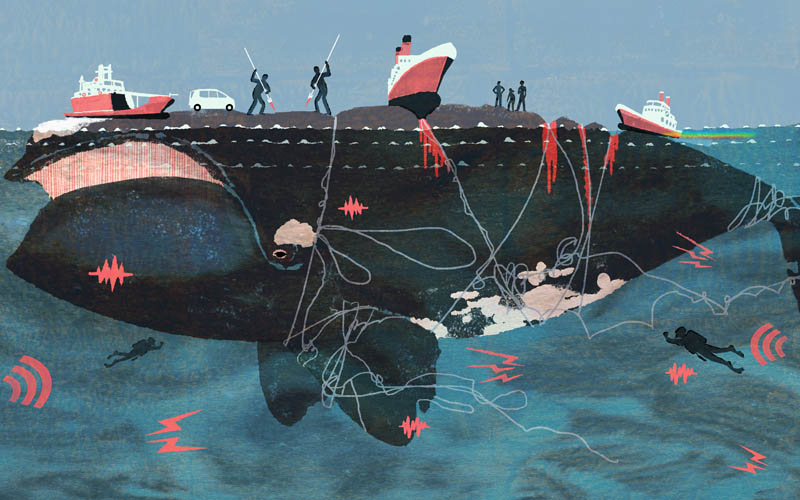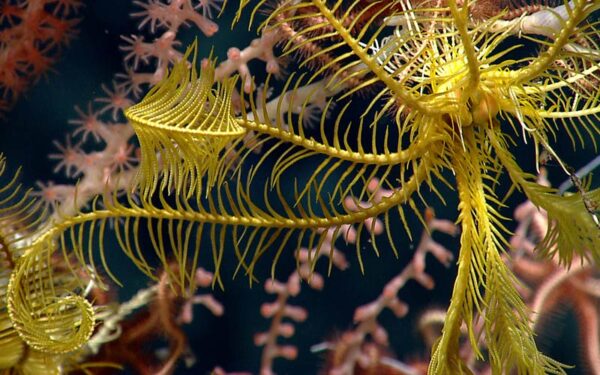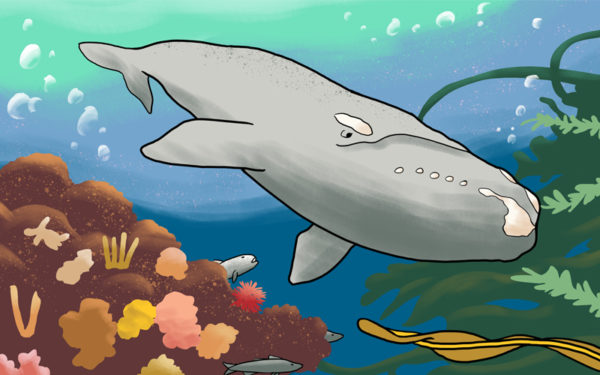
North Atlantic right whales face many threats as they migrate with their new calves, from ship strikes to noise pollution to entanglement in fishing gear. Illustration: Tatsuro
North Atlantic right whales have been described as “urban whales.” They got this name in part because every year, pregnant females, and other members of the population, journey from the Northeast through industrialized waters to coastal areas of off Florida and Georgia to calve. Then they turn around and come back north with their young calves in tow.
The long journey – an obstacle course through shipping lanes, major ports, and a maze of fishing gear – is dangerous, especially for newborn whales navigating such busy waters for the first time. It’s also necessary, as the waters of the Northeast and Canada are abundant with the food these critically endangered whales need to survive.
This year’s northern migration, which started in warm waters off the coast of Florida, brings with it a small ray of hope for right whales. Seven calves have been spotted over the last few months. That’s welcome news for those of us fighting to save this threatened species, especially since no new calves were born last year.
But it’s just the start if we hope to rebuild the right whale population to a sustainable level. With barely 420 whales alive today, we need around 20 calves to be born every year to restore the species. That makes every calf born this year even more precious. And it means we must do everything possible to make sure they stay safe and healthy.
Right now, we aren’t doing enough.
Ship Collisions Can be Deadly – and More Must be Done to Prevent Them
Ship strikes are one of the most significant dangers these rare whales face during their annual migration. Right whales move slowly through the water and feed on the surface, so it can be difficult for large ships to change course when they encounter one. Small boats can also seriously injure and kill whales.
Regulators have taken action to protect right whales from ship strikes before: major shipping lanes have been re-routed and seasonal management areas established. Within these areas, vessels longer than 65 feet must slow down to less than 10 knots during whale migrations. Commercial and recreational boaters also are becoming increasingly aware of right whales thanks to apps like Whale Alert — and are more likely to report whales, keep their distance, and slow down.
However, these actions are not enough. Enforcement of speed restrictions is minimal, and smaller boats are not required to slow down at all. And we can’t count on voluntary action by boaters to ensure whales are protected.
We need regulators to establish more seasonal management areas – and ensure that speed limits are enforced.
A Noisy Ocean Interferes with Whales’ Ability to Communicate and Navigate
As right whales migrate, they depend upon sound to know their location, find food, and maintain contact with one another. They communicate through low-frequency vocalizations described as moans, groans, or pulses. However, increasing noise pollution interferes with their ability to communicate as well as their socializing, feeding, and mating behavior.
Emerging industries like offshore wind are exciting and necessary for our clean energy future, but just the process of installing and operating them can be harmful to right whales due to increased noise. With multiple offshore wind farms proposed along the Atlantic coast, we must take proactive steps to help prevent harm to right whales during construction and operation.
Fortunately, such steps are already underway. CLF and our partners recently reached a historic agreement with Vineyard Wind to mitigate the impacts to whales of their 84-turbine project off the coast of Massachusetts. It includes many best practices for guiding the construction of offshore projects, including restricting construction time when whales are known to be in the area and speed limits for ships traveling to and from the wind farm.
Seismic testing for oil and gas also poses a dire threat to right whales. The testing involves setting off a series of blaring air gun blasts, which are the loudest human sound in the ocean except for explosives. They can disrupt and destroy right whales’ hearing, harming their ability to survive. The Trump administration has proposed seismic testing in the right whales’ migration path, and we’re ready to take action against oil and gas development in the Northeast.
Navigating a Maze of Fishing Gear Can be Fatal
Several fixed gear fisheries along the Atlantic seaboard pose yet another danger to mother-calf pairs journeying north this spring. These fisheries use vertical lines to connect their traps or gillnets on the seafloor to buoys on the surface, creating a maze of thick vertical rope. When an adult right whale gets entangled, the sharp rope cuts into their flesh leaving a nasty scar. More than 85 percent of right whales have entanglement scars.
Adult whales may be strong enough to shake it off or drag the heavy gear long enough to become disentangled, which can sometimes take months or even years. But calves and juvenile whales often aren’t strong enough to shake gear off or drag it. Sadly, they usually drown.
To protect right whales, areas of Cape Cod Bay and the Great South Channel are closed to fishing in the winter and early spring when whales are at their highest numbers. In these areas – where up to half the population may convene at once – fixed fishing gear is removed from the water.
But we could and must do more to protect right whales in New England. They are increasingly stopping in the waters south of Martha’s Vineyard and Nantucket before continuing their migration north or south. By protecting these waters as well, we can improve the whales’ chance of survival.
Fishermen are part of the solution. In Massachusetts, some are experimenting with ropeless (or buoyless) gear as a way to reduce right whale entanglement. Congress, led by Massachusetts Representative Seth Moulton, recently reintroduced the Scientific Assistance for Very Endangered (SAVE) Right Whales Act, which would fund continued development and testing of new technology like ropeless gear as well as research to better understand right whale’s migratory route. It’s a good first step, and one we need you to help support.
New Technology and Increased Protections Can Help
With stronger protections and smart use of technology, right whales can still recover. Ropeless gear can greatly reduce the dangerous vertical lines that entangle and kill whales. Commercial and recreational boaters can do their part with the help of apps like Whale Alert. Offshore wind developers must continue to take right whales into account as they build their new turbines. And the government should create additional protected areas where whales are free to feed and socialize.
New England should welcome all whales, but especially new calves, into a safe ocean. It’s on us to make sure that our waters are a place where they can grow and thrive.
You can help take action by calling on your representatives to take up and pass the SAVE Right Whales Act.



